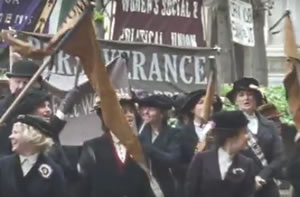How Chiswick Women Said No To The Vote
New research shows that the area was a centre of opposition to female suffrage
The new movie Suffragette, which has just gone on general release in UK cinemas, seeks to tell the story of what the film-makers have called the ‘footsoldiers’ of the women’s suffrage movement in the years before the First World War.
Directed by Sarah Gavon and written by Abi Morgan, the film tries to break and explore new ground in relation to the struggle by British women to gain the vote in the early twentieth century. Instead of telling the more familiar story of the Pankhurst family and the other (mainly) middle-class women who were active with the Women’s Social and Political Union, Suffragette shifts the focus on to the working-class female militants and the (arguably much tougher) problems they faced when trying to become active campaigners.
It is a good and moving film, well worth a viewing by anybody with an interest in British social and political history. While some historians of the period might have reservations about certain aspects of the movie, it still captures the atmosphere of the times very accurately, especially the awful industrial conditions in which women worked in parts of East London.
By sheer coincidence, I have recently been carrying out some research on middle-class ‘defence’ and protest movements in south-west London and – when I was exploring some pre-1914 local sources – I increasingly encountered newspaper reports on suffragette activities. In 1913, for example, two suffragettes set fire to the Tea Pavilion situated at the famous Pagoda in Kew Gardens, completely burning it out. Just a short while later, another suffragette was arrested for setting fire to the letters in the main letters-box of the Post Office in George Street in Richmond.
But what I less prepared for was the extent to which there was also activity by women who opposed the whole idea of votes for women. Indeed, although it might appear a very odd trend when considered now, we tend to forget that – before 1918 – not all women wanted the vote, and some were even prepared to voice their antipathy and mobilise other like-minded women through organised public campaigns. As far as I can tell, there has been surprisingly little research conducted on this type of politics.
The main group involved in this backlash against the suffragettes in the London area was the ‘National League for Opposing Woman Suffrage’, which appears to have been organised and sustained by some very middle-class women. In south-west London, a branch of this organisation was quite active in the leafy middle-class suburbs of Chiswick and the surrounding areas, with other groups at Kew and Richmond.
The Chiswick branch of the National League started life in mid-1909 under the title of the ‘Women’s National Anti-Suffrage League’. In October, 1909, the League held its first general meeting and reported a membership of 56. The following month, a public meeting was organised by the League at Chiswick Town Hall, where one of the women speakers, Miss Kathleen Howieson, warned gravely that the granting of suffrage to women would mean ‘class war’ and ‘Socialism’, and that – in turn – would mean ‘revolution and anarchy’.
Using a combination of further occasional public meetings, letters written to the press, and drawing-room meetings held at private houses, together with some campaigning outside polling stations during elections, the League continued its anti-suffrage activities. At the 3rd AGM of the Chiswick branch, held in late 1911, their Annual Report claimed there was ‘steady growth’ in the membership. In 1912, a ‘well-attended’ social gathering of the League held in the Hogarth Room of Chiswick Town Hall saw a number of speeches being made, all expressing notably conservative and sceptical attitudes to the whole idea of giving women greater rights. Miss Norman Maunder, for example, in her speech, asserted that man ‘was the backbone of the country and women the backbone of the homes of the country’. She said that women were ‘absolutely unfitted’ for governing a nation.
In November, 1913, the League scored quite a publicity coup when they organised a public event at Chiswick Town Hall to debate the following resolution, ‘That it is contrary to the best interests of the State and the Empire that women should have the Parliamentary vote’. Mrs. Norris, the President of the local branch, speaking for the resolution, argued in her address that the ‘whole mentality’ of man was better able to cope with the question of Empire than women, and women’s ‘first duty’ was to the future generation. Miss Coombs, speaking against the resolution, said she did so because she believed that women had ‘the right to be free’. When the audience was invited to vote, 253 supported the League, and 189 were against the resolution, giving the League a majority of 64. Needless to say, the League were evidently very satisfied with this result.
After the outbreak of war in 1914, the Chiswick branch of the National League sent a letter to the local press saying that, given the outbreak of hostilities, they would now ‘drop all outside propaganda work’ for the duration. However, at their 6th AGM held in November that year, Mrs. Norris warned that, while they had ceased political propaganda for the time being, ‘the political aspect was only one side’, and it was still necessary that ‘the cause’ should not be allowed to suffer.
Compared to the suffragette movement, I suspect the National League remained very much a small-scale and minority organisation. However, it would be fascinating to find out more about the anti-suffrage activists, and the extent to which they may have been organising similar campaigns in other parts of the country.
Steve Woodbridge
Steve Woodbridge is a Lecturer in History at Kingston University. This article was orginally published on his blog and is republished here with his kind permission
October 17, 2015
Related links
|
